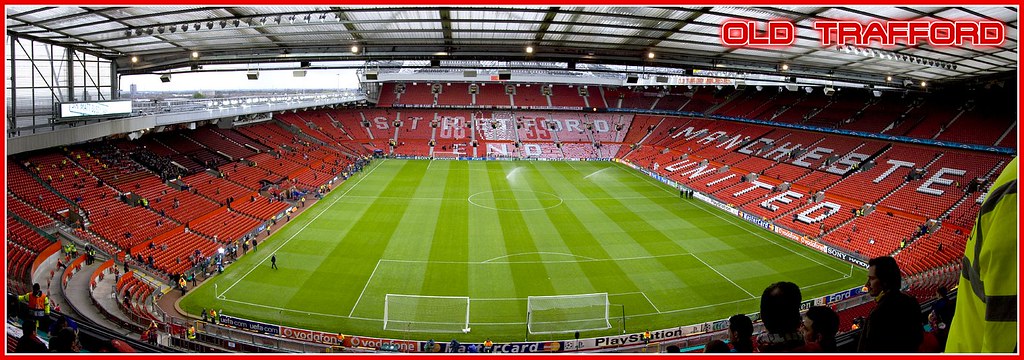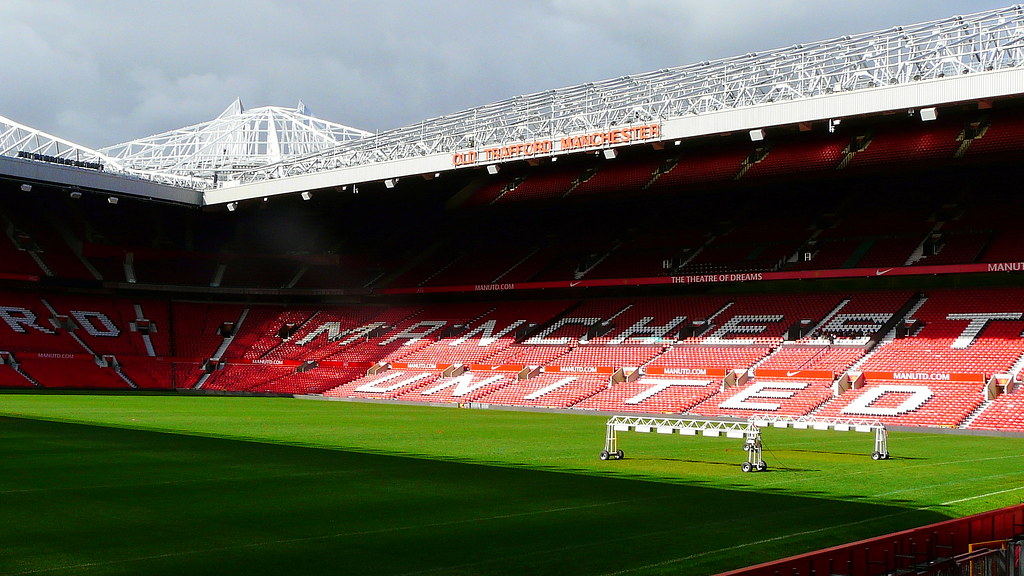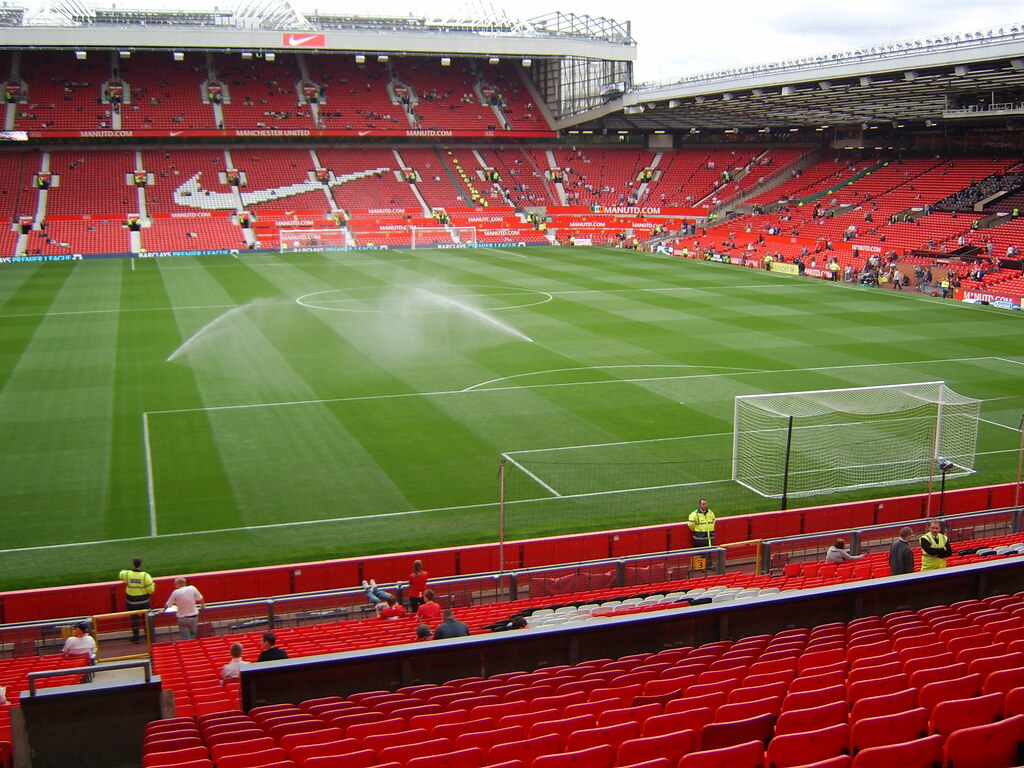Old Trafford
Old Trafford, given the nickname the Theatre of Dreams by Bobby Charlton, is an all-seater football stadium in the Trafford borough of Greater Manchester, England. With space for 76,212 spectators, Old Trafford has the second-largest capacity of any English football stadium after Wembley Stadium and is the only facility in the country to have been given a five-star rating by UEFA. The stadium is approximately 0.5 miles (0.8 km) from Old Trafford Cricket Ground and the adjacent Manchester Metrolink tram station.
Old Trafford was inaugurated in 1910. The stadium was projected by architect Archibald Leitch to host up to 80 000 spectators. The Main Stand was protected by a series of small shelters. The stadium was characterized by large tribunes on every side of the playing field, all connected by closing tiers to create one ring. This continuous ring of tiers was unique in England, because at that time all other English stadiums were characterized by separate tiers with the angles being open.
After the bombings during the Second World War, the stadium was greatly destroyed with some parts of the tiers remaining, as well as the players tunnel that still serves to guide the players to the pitch today. The rest of the stadium was built again in the same shape as designed in the original plans. In 1965 architect Ernest Atherden added a second level of tiers on the North Stand. It was the first time that a stadium contained several balconies. This innovative aspect and the fact that the North Stand contained a large protecting roof, resulted in the stadium to be one of the hosting venues during the 1966 World Cup. Shortly after, a new design led the stadium to be enlarged further.

During the mid nineties, the stadium faced another important series of transformations. All tribunes but the Main Stand were reconstructed and new services such as private boxes, a museum, and the general quarter of Manchester United were added as well.
During the years, the stadium also became the final destination of numerous Red Devils fans - as the typical Manchester United fans are called - whose last wills involved their ashes to be dispersed behind the two doors. The legendary Sir Matt Dusby, memorable trainer of Man United during the fifties and sixties, also found his final destination at the stadium. His statue can be found in front of the main entrance. On February 6th, 1958, seven Man United players were killed in an airplane accident in Munich, Germany. At the inside of the stadium, one can find a clock that stands still at the time the crash happened.
During the years, the stadium also became the final destination of numerous Red Devils fans - as the typical Manchester United fans are called - whose last wills involved their ashes to be dispersed behind the two doors. The legendary Sir Matt Dusby, memorable trainer of Man United during the fifties and sixties, also found his final destination at the stadium. His statue can be found in front of the main entrance. On February 6th, 1958, seven Man United players were killed in an airplane accident in Munich, Germany. At the inside of the stadium, one can find a clock that stands still at the time the crash happened.

Old Trafford is also called The Theatre of Dreams thank to its fascination, the magical atmosphere around the playing field, also characterized by the red seats as in Red Devils. The exterior of the stadium, on the other hand, has a more anonymous character with large parts of mixed bricks alternated with large windows in Plexiglas and surrounded by an imposing structure in steel that contains rectangular supporting beams to hold the roof. Seen from a little distance, the stadium looks like a gigantic warehouse that emerges between the typical little houses in brick, recalling Manchester's history, one of the first cities affected by the Industrial Revolution.
The Old Trafford pitch is surrounded by four covered all-seater stands, officially known as the North, East, South and West Stands. Each stand has at least two tiers, with the exception of the South Stand, which only has one tier due to construction restrictions. The lower tier of each stand is split into Lower and Upper sections, the Lower sections having been converted from terracing in the early 1990s.
The Old Trafford pitch is surrounded by four covered all-seater stands, officially known as the North, East, South and West Stands. Each stand has at least two tiers, with the exception of the South Stand, which only has one tier due to construction restrictions. The lower tier of each stand is split into Lower and Upper sections, the Lower sections having been converted from terracing in the early 1990s.
 Photo by Dakinho
Photo by DakinhoFormerly known as the United Road stand, the North Stand runs over the top of United Road. The stand is three tiers tall, and can hold about 26,000 spectators, the most of the four stands. The North Stand can also accommodate a few fans in executive boxes. The North Stand opened in its current state in 1996, having previously been a single-tiered stand. As the ground's main stand, the North Stand houses many of the ground's more popular facilities, including the Red Café (a Manchester United theme restaurant/bar) and the Manchester United museum and trophy room. Originally opened in 1986 as the first of its kind in the world, the Manchester United museum was in the South-East corner of the ground until it moved to the redeveloped North Stand in 1998. The museum was opened on 11 April 1998 by Pelé and, according to the club's website, it attracts more than 200,000 visitors every year.
Opposite the North Stand is the South Stand, formerly Old Trafford's main stand. Although only a single-tiered stand, the South Stand contains most of the ground's executive suites, and also plays host to any VIPs who may come to watch the match. Members of the media are seated in the middle of the Upper South Stand to give them the best view of the match. The television gantry is also in the South Stand, so the South Stand is the one that gets shown on television least often. Television studios are located at either end of the South Stand, with the club's in-house television station, MUTV, in the East studio and other television stations, such as the BBC and Sky, in the West studio.
Opposite the North Stand is the South Stand, formerly Old Trafford's main stand. Although only a single-tiered stand, the South Stand contains most of the ground's executive suites, and also plays host to any VIPs who may come to watch the match. Members of the media are seated in the middle of the Upper South Stand to give them the best view of the match. The television gantry is also in the South Stand, so the South Stand is the one that gets shown on television least often. Television studios are located at either end of the South Stand, with the club's in-house television station, MUTV, in the East studio and other television stations, such as the BBC and Sky, in the West studio.
 Photo by eucharisto deo
Photo by eucharisto deoThe dugout is in the centre of the South Stand, and is raised above pitch level to give the manager and his coaches an elevated view of the game. Each team's dugout flanks the old players' tunnel, which was used until 1993. The old tunnel is the only remaining part of the original 1910 stadium, having survived the bombing that destroyed much of the stadium during the Second World War. On 6 February 2008, the tunnel was renamed the Munich Tunnel, as a memorial for the 50th anniversary of the 1958 Munich air disaster. The current tunnel is in the South-West corner of the ground, and doubles as an entrance for the emergency services. In the event that large vehicles require access, the seating above the tunnel can be raised by up to 25 feet (7.6 m). The tunnel leads up to the players' dressing room, via the television interview area, and the players' lounge.
Perhaps the best-known stand at Old Trafford is the West Stand, also known as the Stretford End. Traditionally, the stand is where the hard-core United fans are located, and also the ones who make the most noise. Originally designed to hold 20,000 fans, the Stretford End was the last stand to be covered and also the last remaining all-terraced stand at the ground before the forced upgrade to seating in the early 1990s. The work on the Stretford End, which lasted until July 1993, was carried out by Alfred McAlpine. When the second tier was added to the Stretford End in 2000, many fans from the old "K Stand" moved there, and decided to hang banners and flags from the barrier at the front of the tier. So ingrained in Manchester United culture is the Stretford End, that Denis Law was given the nickname "King of the Stretford End", and there is even a statue of Law on the concourse of the stand's upper tier.
Perhaps the best-known stand at Old Trafford is the West Stand, also known as the Stretford End. Traditionally, the stand is where the hard-core United fans are located, and also the ones who make the most noise. Originally designed to hold 20,000 fans, the Stretford End was the last stand to be covered and also the last remaining all-terraced stand at the ground before the forced upgrade to seating in the early 1990s. The work on the Stretford End, which lasted until July 1993, was carried out by Alfred McAlpine. When the second tier was added to the Stretford End in 2000, many fans from the old "K Stand" moved there, and decided to hang banners and flags from the barrier at the front of the tier. So ingrained in Manchester United culture is the Stretford End, that Denis Law was given the nickname "King of the Stretford End", and there is even a statue of Law on the concourse of the stand's upper tier.
 Photo by u_r_slick
Photo by u_r_slickThe pitch at the ground measures approximately 106 metres (116 yd) long by 69 metres (75 yd) wide, with a few metres of run-off space on each side. The centre of the pitch is actually about nine inches higher than the edges, allowing surface water to run off more easily. As at many modern grounds, 10 inches (25 cm) under the pitch is an underground heating system, composed of 23 miles (37 km) of plastic pipes. Club manager Alex Ferguson often requests that the pitch be relaid, most notably half way through the 1998–99 season, when the team won the Treble, at a cost of about £250,000 each time. The grass at Old Trafford is watered regularly, though less on wet days, and mowed three times a week from April to November and once a week from November to March.
The record attendance recorded at Old Trafford was 76,962 for an FA Cup semi-final between Wolverhampton Wanderers and Grimsby Town on 25 March 1939. However, this was before the ground was converted to an all-seater stadium, allowing many more people to fit into the stadium. Old Trafford's record attendance as an all-seater stadium currently stands at 76,098, set at a Premier League game between Manchester United and Blackburn Rovers on 31 March 2007. This is also the Premier League's record attendance. Old Trafford's record attendance for a non-competitive game is 73,738, set on 1 August 2007 for a pre-season friendly between Manchester United and Internazionale. The lowest recorded attendance at a competitive game at Old Trafford in the post-War era was 11,968, as United beat Fulham 3–0 on 29 April 1950. However, on 7 May 1921, the ground hosted a Second Division match between Stockport County and Leicester City for which the official attendance was just 13. This figure is slightly misleading as the ground also contained more than 20,000 spectators who had stayed behind after the match between Manchester United and Derby County earlier that day.
The highest average attendance at Old Trafford over a league season was 75,826, set in the 2006–07 season. The following season saw the greatest total attendance at Old Trafford, as 2,187,408 people watched Manchester United win the Premier League and the UEFA Champions League, and reach the Sixth Round of the FA Cup. The lowest average attendance at Old Trafford came in the 1930–31 season, when an average of 11,685 spectators watched each game.
The record attendance recorded at Old Trafford was 76,962 for an FA Cup semi-final between Wolverhampton Wanderers and Grimsby Town on 25 March 1939. However, this was before the ground was converted to an all-seater stadium, allowing many more people to fit into the stadium. Old Trafford's record attendance as an all-seater stadium currently stands at 76,098, set at a Premier League game between Manchester United and Blackburn Rovers on 31 March 2007. This is also the Premier League's record attendance. Old Trafford's record attendance for a non-competitive game is 73,738, set on 1 August 2007 for a pre-season friendly between Manchester United and Internazionale. The lowest recorded attendance at a competitive game at Old Trafford in the post-War era was 11,968, as United beat Fulham 3–0 on 29 April 1950. However, on 7 May 1921, the ground hosted a Second Division match between Stockport County and Leicester City for which the official attendance was just 13. This figure is slightly misleading as the ground also contained more than 20,000 spectators who had stayed behind after the match between Manchester United and Derby County earlier that day.
The highest average attendance at Old Trafford over a league season was 75,826, set in the 2006–07 season. The following season saw the greatest total attendance at Old Trafford, as 2,187,408 people watched Manchester United win the Premier League and the UEFA Champions League, and reach the Sixth Round of the FA Cup. The lowest average attendance at Old Trafford came in the 1930–31 season, when an average of 11,685 spectators watched each game.


3 comments:
If you desire to take a good deal from this paragraph then you have to apply such strategies to your won webpage.
Also visit my site: Aktive AM review
Definitely believe that which you stated. Your favorite reason seemed to be on the net the easiest thing to be aware of.
I say to you, I definitely get irked while people consider worries that they just do not know about.
You managed to hit the nail upon the top and also defined out the whole
thing without having side-effects , people can take a signal.
Will likely be back to get more. Thanks
My homepage; déménagement commercial
electronic cigarettes, electronic cigarettes, electronic cigarette starter kit, e cig forum, e cigarette, smokeless cigarettes
Post a Comment